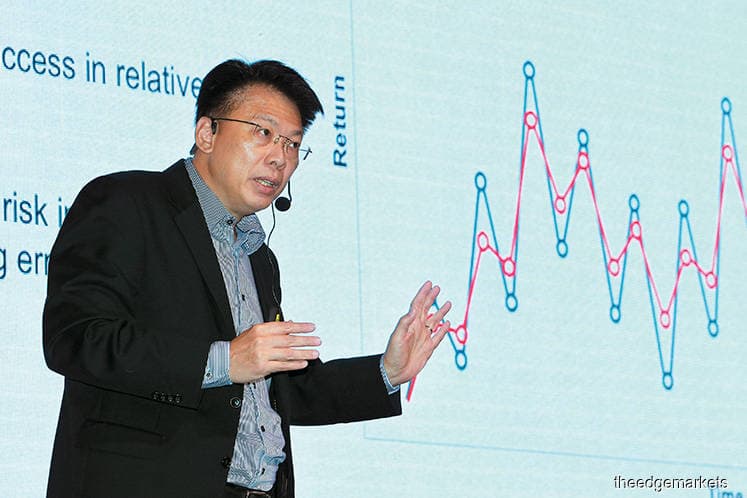
This article first appeared in Personal Wealth, The Edge Malaysia Weekly on March 19, 2018 - March 25, 2018
Investors who have shorter investment horizons and favour less volatility in their portfolios should consider funds that adopt absolute-return strategies. These funds utilise different investment approaches and derivative products to reduce volatility and are less correlated with the overall market, says Chen Fan Fai, head of investments for Asia-Pacific (retail and institutional business) at Eastspring Investments Bhd.
Chen was speaking at the Eastspring Public Symposium 2018, titled “Crouching Bears, Charging Bulls”. During his session on absolute-return strategies and diversification, he explained that these funds employ strategies that help them achieve above-zero returns in all market conditions and cycles.
“If you are an investor in a traditional [unit trust] product, you will get returns over a long period and it can be highly correlated with benchmark indices. By mixing it with some absolute-return products, it will help smoothen out the returns a little better,” says Chen.
“More than half of all unit trust funds have a correlation with the market of more than 75%, whereas half of all funds with absolute-return strategies have a correlation with the market of less than 25%. This makes them an ideal portfolio diversification tool.”
Chen says there is a wide variety of absolute-return strategies that are designed to profit from a fund manager’s skills in altering market exposures. “The challenge is to make money from the exploitation of market inefficiencies and not simply market movements. Overall, we try to keep the volatility low and make the funds less exposed to market risks.”
Absolute-return approaches are commonly employed by hedge funds, which can take both long and short positions to capitalise on market trends. “In hedge funds, financial leverage is used to varying degrees, depending on the manager’s investment process. Options, futures and other derivative securities can also be used to control risks or enhance returns by providing additional leverage,” says Chen.
Absolute-return approaches can be divided into event-driven and arbitrage strategies. The former seek to profit from special opportunities by capitalising on price fluctuations or imbalances while the latter use large amounts of financial leverage.
“An example would be to look for a company that is financially, rather than operationally, distressed. Its balance sheet is overleveraged. Its business was so good that it expanded too fast. But it couldn’t service its debt,” says Chen.
“So what fund managers do is buy the bonds of the company. Then, they actively participate in the restructuring of the company so they can take advantage of the tranche they are holding. When this restructuring works out, the value of the papers they bought will appreciate. That is where they generate returns.”
An example of a portfolio that adopts absolute-return strategies is to have most of its holdings (35%) in domestic stocks, 12% in foreign stocks and 28% in intermediate-term bonds, according to Chen. He also says 11% should be held in money markets while 14% should be in high-yield bonds.
Chen says the performance of funds that employ absolute-return strategies should be assessed from both qualitative and quantitative perspectives. The latter looks at the drawdown experience of the funds, or the amount of money investors could lose in a bear situation.
“It would give you an idea of the type of risk management control that is in place to stop the drawdown and the period of recovery from the fund’s previous peak,” he says, adding that he would also look at the fund’s volatility.
Chen describes the qualitative assessment as understanding the strategies used so as to get an idea of how the funds behave in different environments. “Before you invest, you really need to understand the strategy the fund manager is using to manage the fund. The term ‘absolute’ is generic and different funds have different underlying strategies,” he says.
He adds that while there are not many local funds with absolute-return strategies, he expects to see more offered in the market if there is investor demand.
Eastspring Investments’ absolute-return fund, launched about three years ago, has taught the fund house a few lessons that it could apply to a shariah-compliant version of the fund, which the company plans to launch in the future, says Chen.
Save by subscribing to us for your print and/or digital copy.
P/S: The Edge is also available on Apple's AppStore and Androids' Google Play.